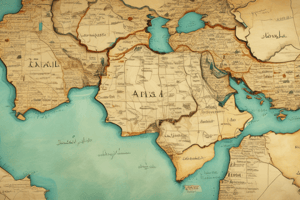Podcast
Questions and Answers
What is the strategic region at the center of the Iran-Iraq conflict?
What is the strategic region at the center of the Iran-Iraq conflict?
The Shatt al-Arab Waterway
Why is the Shatt al-Arab Waterway crucial for Iraq's economy?
Why is the Shatt al-Arab Waterway crucial for Iraq's economy?
It is the only outlet to the sea, crucial for its oil exports.
How does controlling the Shatt al-Arab Waterway support Iran's regional aspirations?
How does controlling the Shatt al-Arab Waterway support Iran's regional aspirations?
It supports its aspirations for regional hegemony in the Persian Gulf.
How did the rugged terrain and diverse landscapes of both countries affect the military strategies during the conflict?
How did the rugged terrain and diverse landscapes of both countries affect the military strategies during the conflict?
What are the historical roots of the Iran-Iraq conflict?
What are the historical roots of the Iran-Iraq conflict?
When did the modern phase of the Iran-Iraq conflict begin?
When did the modern phase of the Iran-Iraq conflict begin?
What event in 1979 intensified the Iran-Iraq conflict?
What event in 1979 intensified the Iran-Iraq conflict?
What was the outcome of the Iran-Iraq War?
What was the outcome of the Iran-Iraq War?
What were the main ideological differences between Iraq and Iran that contributed to their conflict?
What were the main ideological differences between Iraq and Iran that contributed to their conflict?
What was the significance of the 1937 boundary agreement in the context of the Iraq-Iran conflict?
What was the significance of the 1937 boundary agreement in the context of the Iraq-Iran conflict?
What was the outcome of the Algiers Agreement of 1975?
What was the outcome of the Algiers Agreement of 1975?
How did the Iran-Iraq War influence the political landscape of the region?
How did the Iran-Iraq War influence the political landscape of the region?
What was the impact of the 2003 U.S. invasion of Iraq on the conflict with Iran?
What was the impact of the 2003 U.S. invasion of Iraq on the conflict with Iran?
Who were the two notable leaders involved in the Iraq-Iran conflict?
Who were the two notable leaders involved in the Iraq-Iran conflict?
What was the approximate number of casualties resulting from the Iran-Iraq War?
What was the approximate number of casualties resulting from the Iran-Iraq War?
What is the current status of the Iraq-Iran conflict?
What is the current status of the Iraq-Iran conflict?
What are the three consequences of the Iran-Iraq conflict mentioned in the passage?
What are the three consequences of the Iran-Iraq conflict mentioned in the passage?
What is the historical background of the Iran-Iraq conflict?
What is the historical background of the Iran-Iraq conflict?
How did the conflict escalate in the 20th century?
How did the conflict escalate in the 20th century?
What is the geographical significance of the Shatt al-Arab Waterway?
What is the geographical significance of the Shatt al-Arab Waterway?
Why has the conflict remained unresolved?
Why has the conflict remained unresolved?
How would you describe the Iran-Iraq conflict in modern Middle Eastern history?
How would you describe the Iran-Iraq conflict in modern Middle Eastern history?
What are the two main factors that have contributed to the conflict's protracted nature?
What are the two main factors that have contributed to the conflict's protracted nature?
What is the overall conclusion about the Iran-Iraq conflict?
What is the overall conclusion about the Iran-Iraq conflict?
How did the Iran-Iraq War impact the political landscape of the Middle East?
How did the Iran-Iraq War impact the political landscape of the Middle East?
What role did ethnic tensions play in the Iran-Iraq conflict?
What role did ethnic tensions play in the Iran-Iraq conflict?
What was the significance of Saddam Hussein's rejection of the 1937 boundary agreement?
What was the significance of Saddam Hussein's rejection of the 1937 boundary agreement?
What are the main factors that have contributed to the long-standing nature of the Iran-Iraq conflict?
What are the main factors that have contributed to the long-standing nature of the Iran-Iraq conflict?
What is the significance of the Iran-Iraq conflict in modern Middle Eastern history?
What is the significance of the Iran-Iraq conflict in modern Middle Eastern history?
How did the 2003 U.S. invasion of Iraq impact the balance of power in the region?
How did the 2003 U.S. invasion of Iraq impact the balance of power in the region?
What were the major ideological differences between Iraq and Iran that contributed to their conflict?
What were the major ideological differences between Iraq and Iran that contributed to their conflict?
What are the consequences of the Iran-Iraq conflict mentioned in the passage?
What are the consequences of the Iran-Iraq conflict mentioned in the passage?
What role did external interventions play in the Iran-Iraq conflict?
What role did external interventions play in the Iran-Iraq conflict?
What has been the impact of the Iran-Iraq conflict on the region?
What has been the impact of the Iran-Iraq conflict on the region?
How has the historical context of the Iran-Iraq conflict contributed to its protracted nature?
How has the historical context of the Iran-Iraq conflict contributed to its protracted nature?
What is the significance of the Algiers Agreement of 1975 in the context of the Iran-Iraq conflict?
What is the significance of the Algiers Agreement of 1975 in the context of the Iran-Iraq conflict?
How would you describe the ongoing conflict between Iraq and Iran?
How would you describe the ongoing conflict between Iraq and Iran?
What is the current state of the Iran-Iraq conflict?
What is the current state of the Iran-Iraq conflict?
What is the role of the Shatt al-Arab Waterway in the Iran-Iraq conflict?
What is the role of the Shatt al-Arab Waterway in the Iran-Iraq conflict?
What is the impact of the conflict's protracted nature on the region?
What is the impact of the conflict's protracted nature on the region?
What is the geographical feature that provides essential access to the Persian Gulf for both Iran and Iraq?
What is the geographical feature that provides essential access to the Persian Gulf for both Iran and Iraq?
What event in 1934 marked the beginning of the modern phase of the Iran-Iraq conflict?
What event in 1934 marked the beginning of the modern phase of the Iran-Iraq conflict?
What was the outcome of the Iran-Iraq War?
What was the outcome of the Iran-Iraq War?
What is the significance of the 1979 Iranian Islamic Revolution in the context of the Iran-Iraq conflict?
What is the significance of the 1979 Iranian Islamic Revolution in the context of the Iran-Iraq conflict?
What is a key feature of the terrain in both Iran and Iraq that affected the military strategies during the conflict?
What is a key feature of the terrain in both Iran and Iraq that affected the military strategies during the conflict?
What is the main ideological difference between Iraq and Iran that contributed to their conflict?
What is the main ideological difference between Iraq and Iran that contributed to their conflict?
What is the significance of the Shatt al-Arab Waterway for Iran's regional aspirations?
What is the significance of the Shatt al-Arab Waterway for Iran's regional aspirations?
What is the current status of the Iraq-Iran conflict?
What is the current status of the Iraq-Iran conflict?
Flashcards are hidden until you start studying
Study Notes
Geography
- The Iran-Iraq conflict centers on the strategic Shatt al-Arab Waterway, a critical waterway formed by the confluence of the Tigris and Euphrates rivers, providing essential access to the Persian Gulf.
- The Shatt al-Arab is vital for both nations for economic and strategic reasons, with Iraq relying on it as its only outlet to the sea for oil exports, and Iran seeking to control or access it for regional hegemony.
- The rugged terrain and diverse landscapes of both countries influenced military strategies during the conflict.
History
- The historical roots of the Iran-Iraq conflict date back to ancient hostilities between Persian and Arab civilizations.
- The modern phase of the conflict began in 1934 over territorial disputes concerning the Shatt al-Arab Waterway.
- The conflict intensified with the Iranian Islamic Revolution in 1979, leading to the Iran-Iraq War (1980-1988) that resulted in a stalemate and massive casualties on both sides.
Politics
- The political dynamics of the conflict are characterized by ideological, ethnic, and sectarian differences.
- Iraq, under Saddam Hussein, pursued Arab nationalism and a secular state model, clashing with Iran’s Shiite Islamist ideology promoted by Ayatollah Khomeini.
- Key political decisions include Iraq’s rejection of the 1937 boundary agreement and its declaration of sovereignty over the entire Shatt al-Arab in 1959, and the Algiers Agreement of 1975.
Facts
- The modern phase of the conflict began in 1934 and remains unresolved today.
- Notable leaders include Saddam Hussein of Iraq and Ayatollah Khomeini of Iran.
- Major external interventions came from global powers such as the U.S. and USSR, and regional actors.
- Key events include the initial dispute over the Shatt al-Arab in 1934, the Iran-Iraq War (1980-1988), and the 2003 U.S. invasion of Iraq.
- The conflict remains unresolved but dormant, with occasional diplomatic and military tensions.
- The conflict has led to significant loss of life, economic devastation, and long-term regional instability.
Geography
- The Iran-Iraq conflict centers on the strategic Shatt al-Arab Waterway, a critical waterway formed by the confluence of the Tigris and Euphrates rivers, providing essential access to the Persian Gulf.
- The Shatt al-Arab is vital for both nations for economic and strategic reasons, with Iraq relying on it as its only outlet to the sea for oil exports, and Iran seeking to control or access it for regional hegemony.
- The rugged terrain and diverse landscapes of both countries influenced military strategies during the conflict.
History
- The historical roots of the Iran-Iraq conflict date back to ancient hostilities between Persian and Arab civilizations.
- The modern phase of the conflict began in 1934 over territorial disputes concerning the Shatt al-Arab Waterway.
- The conflict intensified with the Iranian Islamic Revolution in 1979, leading to the Iran-Iraq War (1980-1988) that resulted in a stalemate and massive casualties on both sides.
Politics
- The political dynamics of the conflict are characterized by ideological, ethnic, and sectarian differences.
- Iraq, under Saddam Hussein, pursued Arab nationalism and a secular state model, clashing with Iran’s Shiite Islamist ideology promoted by Ayatollah Khomeini.
- Key political decisions include Iraq’s rejection of the 1937 boundary agreement and its declaration of sovereignty over the entire Shatt al-Arab in 1959, and the Algiers Agreement of 1975.
Facts
- The modern phase of the conflict began in 1934 and remains unresolved today.
- Notable leaders include Saddam Hussein of Iraq and Ayatollah Khomeini of Iran.
- Major external interventions came from global powers such as the U.S. and USSR, and regional actors.
- Key events include the initial dispute over the Shatt al-Arab in 1934, the Iran-Iraq War (1980-1988), and the 2003 U.S. invasion of Iraq.
- The conflict remains unresolved but dormant, with occasional diplomatic and military tensions.
- The conflict has led to significant loss of life, economic devastation, and long-term regional instability.
Studying That Suits You
Use AI to generate personalized quizzes and flashcards to suit your learning preferences.




